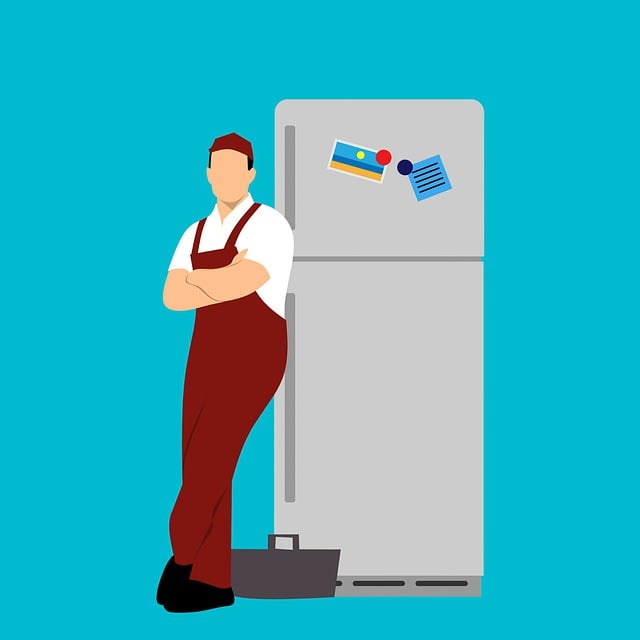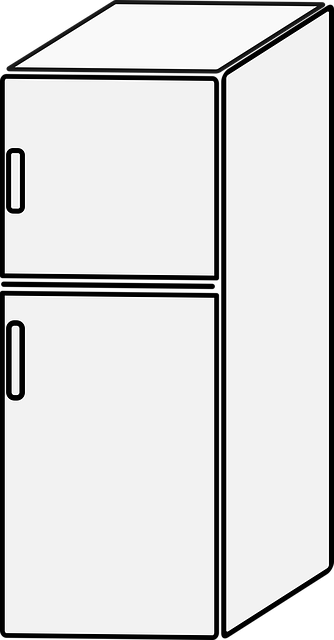If your refrigerator stops working or exhibits issues like excessive heat, frost buildup, unusual sounds, or not cooling effectively, prompt action is crucial to protect your food and ensure safety. Begin by confirming the appliance is connected properly to a power source and that no circuits have tripped. Check the thermostat settings and clean any dust from the condenser coils. If the door seals are damaged or if there's an issue with the temperature regulation system, address these immediately. For basic problems like loose parts, power supply issues, or minor electrical faults, you may be able to resolve them yourself using a simple repair kit equipped for refrigerator repair. However, for more complex issues involving the compressor, condenser fan, or significant cooling malfunctions, professional refrigerator repair services are recommended due to the delicate nature of these components and potential safety risks. An emergency repair kit can aid in temporary fixes until a professional can assess and perform comprehensive repairs. Always refer to your user manual for specific guidance and safety precautions during troubleshooting and repair.
When your refrigerator halts its vital role in preserving your perishables, prompt action is essential. This article navigates through the immediate steps necessary when your fridge ceases to function, guiding you through common emergency refrigerator problems and their quick diagnostics. It equips you with DIY solutions for urgent refrigerator issues, ensuring you can troubleshoot effectively. Recognize when it’s time to enlist a professional for expert refrigerator repair help, and learn how to assemble and utilize an emergency repair kit for optimal results. Mastering these skills can prevent food spoilage and maintain your household’s health and safety.
- Immediate Steps to Take When Your Fridge Stops Working
- Identifying the Issue: Common Emergency Refrigerator Problems
- Quick Diagnostics: How to Check Major Refrigerator Components
- DIY Solutions: Troubleshooting Tips for Urgent Refrigerator Issues
- When to Call a Professional: Signs Your Fridge Repair Needs Expert Help
- Emergency Repair Kits: What to Include and How to Use Them Effectively
Immediate Steps to Take When Your Fridge Stops Working

In the event your refrigerator ceases to function, immediate action is crucial to prevent food spoilage and potential losses. The initial step is to unplug the appliance to avoid any electrical hazards, especially if there’s a visible spark, strange noise, or an unusual smell coming from the unit. Once the refrigerator is safely powered down, inspect the power cord, outlet, and fuse or circuit breaker to ensure there is no disruption in the electrical supply. If everything seems intact electrically, check the interior and exterior for any obvious signs of malfunction such as a faulty thermostat, broken door seal, or blocked vents that could impede proper cooling. Should you notice a specific issue like a tripped circuit breaker or a loose wire, correcting it may restore functionality. However, if the problem is not apparent, it’s advisable to contact a professional for refrigerator repair to diagnose and fix the underlying issue before your perishables are at risk of spoilage. In the meantime, if the repair is not immediate, consider transferring perishable items to a working refrigerator or freezer elsewhere, or use an ice-filled cooler as a temporary measure to keep your food safe for consumption.
Identifying the Issue: Common Emergency Refrigerator Problems

When faced with an urgent refrigerator malfunction, timely identification of the issue is crucial for preserving the integrity of perishable items and maintaining food safety. Common emergency refrigerator problems that may require immediate refrigerator repair include a fridge that’s not cooling, excessive frost buildup on the evaporator coils, unusual noises emanating from within the appliance, or a refrigerator that’s cycling on and off erratically. If the interior temperature exceeds 40 degrees Fahrenheit, it’s essential to act promptly. A fridge not cooling can be due to a malfunctioning thermostat, a clogged or dirty air vent, or a faulty door seal that allows warm air to seep in. Excessive frost can indicate improper defrosting cycles or issues with the refrigerator’s temperature regulation system. Unusual sounds may point to loose internal components, such as the evaporator fan, which could be causing the problem. To address these issues effectively, it’s important to troubleshoot and perform basic refrigerator repair tasks, ensuring that the appliance functions correctly and safely until a professional can assess the situation.
Quick Diagnostics: How to Check Major Refrigerator Components

In the event of an emergency with your refrigerator, prompt diagnostics can save your perishables and prevent further complications. When faced with a malfunctioning fridge, it’s crucial to perform quick checks on major components. Start by examining the power connections and ensuring that the unit is properly plugged in and that any associated switches are turned on. Verify that the thermostat is functioning correctly as it regulates the temperature within the appliance. If everything seems intact with the electrical supply, proceed to inspect the condenser coils located at the back or bottom of the fridge. Clear any obstructions or dust accumulation, as these can impede heat dissipation and affect performance. Next, check the door seals by closing the door on a piece of paper or a simple object; if it slides out easily, the seal may be compromised, causing the refrigerator to work harder and potentially fail. Additionally, verify that the internal temperature settings are set appropriately, as incorrect settings can lead to improper cooling. These steps are integral for identifying common issues in refrigerator repair without the need for professional intervention right away. By systematically going through these diagnostics, you can often pinpoint the cause of the problem and make immediate adjustments or repairs to restore your fridge’s function.
DIY Solutions: Troubleshooting Tips for Urgent Refrigerator Issues

When faced with urgent refrigerator issues, timely solutions are paramount to prevent food spoilage and maintain a safe environment. If your refrigerator is not operating correctly, start by checking the power supply and ensuring the unit is plugged in properly. If the power is on but the fridge is still not functioning, inspect the thermostat settings to verify they are set correctly. A common issue that can be quickly addressed is a tripped circuit breaker or blown fuse. Resetting these can often restore functionality. Additionally, examine the coils at the back of the refrigerator; cleaning any accumulated dust can improve efficiency and performance.
In instances where the refrigerator is not cooling adequately, first, check the temperature setting to ensure it’s not set too high. Then, inspect the door seals for proper closure as even minor gaps can significantly affect the unit’s ability to maintain a cold temperature. If the seals are compromised, cool air will escape, and warm air will enter, leading to inefficiency. Another quick fix is to ensure that the vents inside the fridge and freezer are not blocked by food items or condiments, as this can impede airflow and affect the cooling process. For issues like a malfunctioning compressor or condenser fan, it’s crucial to have the necessary technical knowledge or consult professional assistance, as these components require careful handling to avoid further damage.
When to Call a Professional: Signs Your Fridge Repair Needs Expert Help

When your refrigerator is on the fritz, timely intervention is crucial to prevent food spoilage and maintain the safety of your perishables. While some issues can be resolved with basic troubleshooting or DIY repairs, there are instances when professional refrigerator repair expertise is necessary. If your fridge is not cooling effectively, resulting in temperatures that fail to maintain the appropriate range for food preservation, it’s time to call a pro. They possess specialized tools and knowledge to diagnose and fix such temperature regulation problems swiftly. Similarly, if you notice any unusual sounds or smells coming from the unit, or if there are signs of water leaks or electrical issues like flickering lights near the fridge, these are clear indicators that expert help is required. These symptoms could suggest a range of underlying complications, from faulty compressors to compromised insulation, which can be hazardous and require professional refrigerator repair skills to address safely and effectively. It’s always better to err on the side of caution and seek professional assistance when faced with such complex issues.
Emergency Repair Kits: What to Include and How to Use Them Effectively

When an urgent refrigerator malfunction occurs, having an emergency repair kit on hand can be a lifesaver for preserving perishables and preventing further damage. A well-stocked refrigerator repair kit should include essential tools and components commonly needed for quick fixes. Among these are a multimeter for diagnosing electrical issues, a set of screwdrivers for disassembly, insulating tape for temporary fixes, replacement fuses or circuit breakers, and a small selection of spare parts such as thermostat wires, door seals, and bulbs. For electrical troubleshooting, ensure you have extra fuses that match your fridge’s specifications, as incorrect replacements can pose fire hazards. In the event of a coolant leak, keep a non-toxic, food-safe refrigerant like isobutane or propane readily available, along with the necessary refill tools. Always refer to the user manual for safety and model-specific guidelines before attempting repairs. Proceed with caution, especially when dealing with electrical components or gas-based systems. If the issue persists after your emergency fix, it’s advisable to contact a professional repair service to avoid any potential risks or further complications. Regularly updating your emergency kit with tools and parts appropriate for your fridge model will enhance its effectiveness in critical situations.
When faced with an urgent refrigerator malfunction, prompt action is critical to safeguard your perishables. This article has provided a concise guide on immediate steps to take and common issues that can cause your fridge to cease functioning properly. Through quick diagnostics and DIY troubleshooting tips, you are now equipped with the knowledge to assess and potentially resolve many urgent refrigerator problems. However, recognizing when professional help is necessary is also a key aspect of effective refrigerator repair. Emergency repair kits, as outlined, can be invaluable tools for such situations. Remember to act swiftly but safely; your food’s integrity and your health depend on it. With these strategies in hand, you are well-prepared to handle unexpected fridge issues with confidence.
